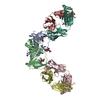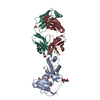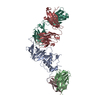+Search query
-Structure paper
| Title | Crimean-Congo hemorrhagic fever survivors elicit protective non-neutralizing antibodies that target 11 overlapping regions on glycoprotein GP38. |
|---|---|
| Journal, issue, pages | Cell Rep, Vol. 43, Issue 7, Page 114502, Year 2024 |
| Publish date | Jul 23, 2024 |
 Authors Authors | Olivia S Shin / Stephanie R Monticelli / Christy K Hjorth / Vladlena Hornet / Michael Doyle / Dafna Abelson / Ana I Kuehne / Albert Wang / Russell R Bakken / Akaash K Mishra / Marissa Middlecamp / Elizabeth Champney / Lauran Stuart / Daniel P Maurer / Jiannan Li / Jacob Berrigan / Jennifer Barajas / Stephen Balinandi / Julius J Lutwama / Leslie Lobel / Larry Zeitlin / Laura M Walker / John M Dye / Kartik Chandran / Andrew S Herbert / Noel T Pauli / Jason S McLellan /   |
| PubMed Abstract | Crimean-Congo hemorrhagic fever virus can cause lethal disease in humans yet there are no approved medical countermeasures. Viral glycoprotein GP38, exclusive to Nairoviridae, is a target of ...Crimean-Congo hemorrhagic fever virus can cause lethal disease in humans yet there are no approved medical countermeasures. Viral glycoprotein GP38, exclusive to Nairoviridae, is a target of protective antibodies and is a key antigen in preclinical vaccine candidates. Here, we isolate 188 GP38-specific antibodies from human survivors of infection. Competition experiments show that these antibodies bind across 5 distinct antigenic sites, encompassing 11 overlapping regions. Additionally, we show structures of GP38 bound with 9 of these antibodies targeting different antigenic sites. Although these GP38-specific antibodies are non-neutralizing, several display protective efficacy equal to or better than murine antibody 13G8 in two highly stringent rodent models of infection. Together, these data expand our understanding regarding this important viral protein and may inform the development of broadly effective CCHFV antibody therapeutics. |
 External links External links |  Cell Rep / Cell Rep /  PubMed:39002130 / PubMed:39002130 /  PubMed Central PubMed Central |
| Methods | EM (single particle) / X-ray diffraction |
| Resolution | 1.8 - 5.6 Å |
| Structure data |  EMDB-43551: CCHFV GP38 bound with ADI-46143 and ADI-46158 Fabs  EMDB-43552: CCHFV GP38 bound with ADI-58062 and ADI-63530 Fabs  EMDB-43553: CCHFV GP38 bound with ADI-58026 and ADI-63547 Fabs EMDB-43604, PDB-8vww:  PDB-8vvk:  PDB-8vvl: |
| Chemicals |  ChemComp-HOH:  ChemComp-NAG:  ChemComp-SO4:  ChemComp-CL:  ChemComp-CO: |
| Source |
|
 Keywords Keywords | VIRAL PROTEIN/IMMUNE SYSTEM / CCHFV / GP38 / Antibody / Immunology / VIRAL PROTEIN / VIRAL PROTEIN-IMMUNE SYSTEM complex |
 Movie
Movie Controller
Controller Structure viewers
Structure viewers About Yorodumi Papers
About Yorodumi Papers





 homo sapiens (human)
homo sapiens (human) crimean-congo hemorrhagic fever virus
crimean-congo hemorrhagic fever virus
